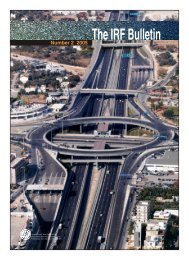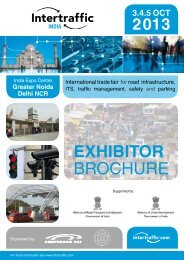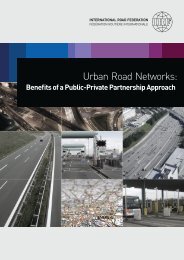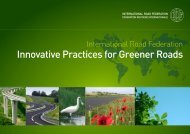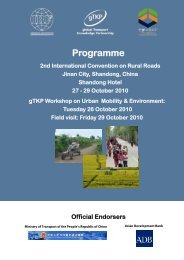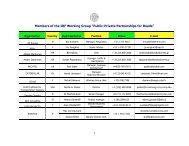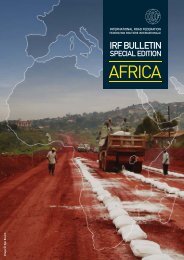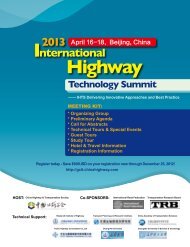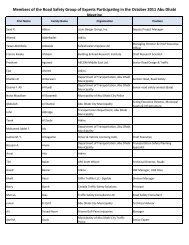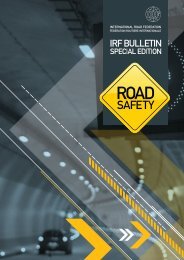TRANSPORT
TRANSPORT
TRANSPORT
- No tags were found...
Create successful ePaper yourself
Turn your PDF publications into a flip-book with our unique Google optimized e-Paper software.
ROAD SAFETY<br />
ROAD SAFETY<br />
Road Safety versus Mobility:<br />
The Dilemma of Managing<br />
Rural Transport in Africa<br />
Robert Tama Lisinge<br />
Highway and Transportation Engineer, Economic<br />
Affairs Officer, United Nations Economic<br />
Commission for Africa<br />
This article is a reflection on the special challenges of<br />
road safety in Africa’s rural areas. It examines the complex<br />
relationship between the rural transportation system and<br />
national road safety rules and regulations, and explores the<br />
implications for rural livelihoods. It also examines recent<br />
efforts to mainstream rural concerns in road safety policy at<br />
national and regional levels, and provides insights on ways<br />
of cushioning negative impacts of enforcing road safety<br />
measures on rural mobility.<br />
Poor road conditions, old vehicle fleets, excessive<br />
overloading and mixed traffic are major risk factors<br />
in rural areas<br />
All the components of the rural transport system in most<br />
African countries – road infrastructure, vehicles, and road<br />
users – contribute significantly to road crashes. Generally,<br />
the continent’s road transport network is inadequate<br />
compared to other regions of the world, notably in terms<br />
of density, distribution in relation to the population and<br />
quality. The situation is worse in rural areas, where existing<br />
roads are predominantly narrow, unpaved and in bad<br />
condition due to lack of regular maintenance. Many of<br />
these roads are very slippery during the wet season and<br />
thus dangerous for driving, especially those without side<br />
protection and constructed on terrain with steep hills and<br />
deep valleys. Some bridges are in a state of disrepair and<br />
dangerous for use by vehicles. In addition, encroaching<br />
vegetation has further narrowed numerous rural roads,<br />
making them unsafe for both drivers and pedestrians.<br />
Many of the existing paved roads are also very narrow<br />
and in bad condition. A number of African countries,<br />
such as Ethiopia, are implementing ambitious road sector<br />
development programmes to address some of these issues,<br />
and are already recording improvements in the coverage<br />
and quality of their networks. However, significant<br />
reduction in rural road infrastructure gaps remains a longterm<br />
prospect.<br />
Generally, African countries also have very old vehicle<br />
fleets. In Ethiopia, it is estimated that vehicles imported<br />
to the country are on average 20 or more years old, and<br />
that the age of the national vehicle fleet is 30 or more<br />
years. In Tanzania, the average age of vehicles is reported<br />
to be 15 years. Overall, it is the worst of these old vehicles<br />
that are used for providing transport services in rural<br />
areas. This is a direct result of the appalling condition of<br />
most rural roads, which raises vehicle-operating costs<br />
and discourages transport operators from using relatively<br />
new vehicles to provide services. To maximise profits, the<br />
few operators that serve rural areas tend to modify their<br />
vehicles to increase carrying capacity. Vehicles are also<br />
modified to withstand the rough conditions of rural roads.<br />
Such modifications may affect the structural integrity of<br />
the vehicle, thus creating enormous risks to the safety of<br />
drivers and passengers.<br />
Overloading of vehicles is common in rural areas as a result<br />
of very low traffic levels. In a passenger survey undertaken<br />
in Cameroon for a type of vehicle designed for a maximum<br />
passenger capacity of five, 50% of the surveyed vehicles<br />
carried 8 or 9 passengers. It was observed that some of<br />
the cars carried up to 15 passengers. It was also noted that<br />
operators allowed desperate commuters to sit on the roofs<br />
of moving vehicles, which is dangerous as the roads are<br />
bad and some of the drivers are reckless.<br />
Another phenomenon in rural areas that raises concern<br />
is that of mixed transport of people, goods and animals,<br />
notably cattle, in the same vehicle. This is mostly the case<br />
in cattle rearing areas, where movement of cattle along<br />
highways is also rampant and a major cause of crashes.<br />
In Ethiopia, animal strikes are actually reported as being<br />
one of the leading causes of road accidents. In general,<br />
mixed traffic is common in Africa’s rural areas – with cars,<br />
motorcycles, bicycles, horse and donkey carts, as well as<br />
pedestrians all sharing the same narrow pavement. In<br />
Tanzania, efforts are made to erect signs indicating cattle<br />
crossing locations, but these signs do not last for long due<br />
to road furniture vandalism. The resulting absence of such<br />
signs exposes drivers to serious problems at cattle crossings.<br />
IRF BULLETIN SPECIAL EDITION: RURAL <strong>TRANSPORT</strong>, VOLUME-2 |<br />
15



